Are you a Quiet Speculation member?
If not, now is a perfect time to join up! Our powerful tools, breaking-news analysis, and exclusive Discord channel will make sure you stay up to date and ahead of the curve.
It's summer. There's not much happening on the Magic front. And I've got summer things to do. So I'm giving in and doing a list article. At least the algorithm will be satisfied. And I still have my professional pride preventing me from doing it in a nonanalytical way.
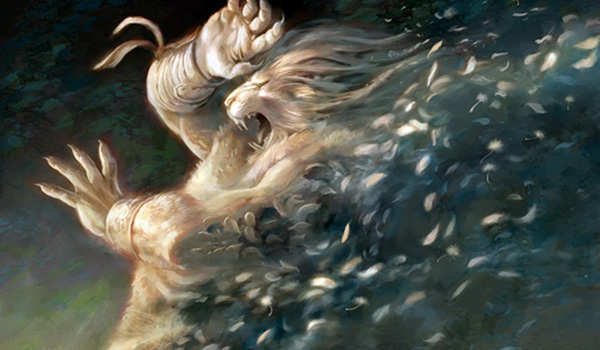
The Online Metagame
An explainer/disclaimer before I start: everything I'm going to say about metagame position applies to the MTGO metagame and only the MTGO metagame. This is mainly because MTGO is almost my only source of data right now. MTGMelee generates a usable result or two monthly, and while I know there are paper Modern events happening, the ones I can use don't seem to get posted anywhere. Thus I am only ever really addressing that metagame, and your experiences will vary wildly if you play in paper or in non-MTGO premier events.
MTGO in Crisis
The secondary reason is that it's MTGO with the problem I need to address. If you aren't MTGO itself or a dedicated MTGO player, skip this section, I'm not talking to you. Everyone else gone? Good.
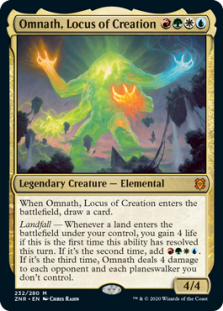 MTGO, you have a problem. You have no demonstrated ability to focus. You just swing wildly and alarmingly between whichever deck strikes your fancy, use it up, and immediately discard it in favor of the Hot New Thing. It's happened three times this year so far, and is happening again. In the beginning, everything looked fine. The metagame was evolving along an understandable trajectory based on what had happened before and the card pool. However, you've simply gone nuts since the February bannings. The top deck of one month suddenly crashes into irrelevance as another deck rises to take its place. In March it was Jund Shadow, which was replaced by Heliod Company, which was completely dethroned by UR Prowess, then Amulet Titan. I don't know what deck will win for July, but at the current rate, Amulet Titan won't even make July's tier list. This isn't metagame shifts, this is harmful behavior.
MTGO, you have a problem. You have no demonstrated ability to focus. You just swing wildly and alarmingly between whichever deck strikes your fancy, use it up, and immediately discard it in favor of the Hot New Thing. It's happened three times this year so far, and is happening again. In the beginning, everything looked fine. The metagame was evolving along an understandable trajectory based on what had happened before and the card pool. However, you've simply gone nuts since the February bannings. The top deck of one month suddenly crashes into irrelevance as another deck rises to take its place. In March it was Jund Shadow, which was replaced by Heliod Company, which was completely dethroned by UR Prowess, then Amulet Titan. I don't know what deck will win for July, but at the current rate, Amulet Titan won't even make July's tier list. This isn't metagame shifts, this is harmful behavior.
MTGO, you need help. Your behavior is akin to ADHD or bipolar disorder. I'm not qualified to provide the help you need, but it is available. Go and find it so that I don't have to comment on your violent swings and inconsistencies every. Single. Month. Some stability and discipline will be good for you and better for all your players. Get help!
Standards
Alright, with that off my chest, it's time to actually focus on the title topic. The metagame has shifted a lot recently and subsequently some cards are seeing more or less play than at the start of the year. This is perfectly natural and to be expected. Especially when a set as 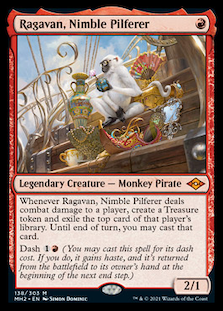 consequential as Modern Horizons 2 is released. And in normal circumstances, established staples being replaced by new cards or older ones that are better in context isn't worth discussing.
consequential as Modern Horizons 2 is released. And in normal circumstances, established staples being replaced by new cards or older ones that are better in context isn't worth discussing.
However, these aren't normal circumstances. A new and very Legacy-lite deck is all the rage, which in turn has the community in a bit of a rage. Calls for a ban right after a metagame shift are nothing new and generally worth ignoring. However, this time around, I'm a bit triggered because a lot of what's being complained about is perfectly answerable by existing cards that for some reason aren't seeing play. And a few that have actually dropped off concurrent with the spike in decks said cards are primed to answer. And therefore today's list is those underplayed cards that are strong answers against the top decks in Modern, but for whatever reason don't get the love they deserve.
Of course, to do this properly I need a rating system. Jordan's done a lot of these articles over the years, and his template is solid. Take three criteria, rate each card out of five, order the list based on their score. I'm going to use different criteria than him to more accurately make my point. Do note that all this is fairly subjective and I'm always open to debating the points.
Efficacy
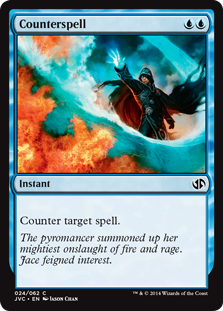 How easily does the card achieve a desired end? Not every card is equally effective at all tasks. If there's ever a card that actually does everything at a good price it will hopefully be banned. What I'm looking at is how well the card does whatever it's meant to do. For example, Counterspell rates very high as a general-purpose answer (the point of Counterspell), but very low as a win condition (it's just not a win condition).
How easily does the card achieve a desired end? Not every card is equally effective at all tasks. If there's ever a card that actually does everything at a good price it will hopefully be banned. What I'm looking at is how well the card does whatever it's meant to do. For example, Counterspell rates very high as a general-purpose answer (the point of Counterspell), but very low as a win condition (it's just not a win condition).
Mana cost is an amplifying consideration for this category. Being cheap doesn't automatically make a card effective, but a cheap and effective card will rate higher than an equally effective one that's more expensive. Thoughtseize would score higher than Grief for that reason.
Meta Versatility
How useful is this answer card in the current metagame? Maindeck and sideboard space are valuable commodities. Running narrow answers is a calculated risk when specific decks are highly represented, but in general it's better to run cards that are useful against a wide range of decks. The more decks a card would be useful against (for maindeck cards) or brought in (for sideboard cards) the more versatile it is given what is actually seeing play right now.
Splashability
How easily can decks run this card? Jordan's used this one a lot, and I'll let him speak for it himself:
Splashability will be rated by considering how many existing Modern decks can accommodate the card and whether they’ll want it. For example, despite its lack of a color identity, Ghost Quarter doesn’t fit into BGx midrange decks. These decks can easily run Fulminator Mage as mana disruption instead, and prefer not to miss a land drop if they don’t have to.
#5: Shatterstorm: 9/15
 First up is the earliest and most definitive Go-Away-Artifacts card in Magic, Shatterstorm. Both Affinity and Urza, Lord High Artificer decks are making a resurgence, with the latter associated with the various The Underworld Cookbook Food synergy decks. These decks and to a lesser extent Hammer Time are flooding boards with random artifacts and Affinity and Food have Welding Jar, so a card that kills every artifact and foils Jar is essential to keep from being swamped.
First up is the earliest and most definitive Go-Away-Artifacts card in Magic, Shatterstorm. Both Affinity and Urza, Lord High Artificer decks are making a resurgence, with the latter associated with the various The Underworld Cookbook Food synergy decks. These decks and to a lesser extent Hammer Time are flooding boards with random artifacts and Affinity and Food have Welding Jar, so a card that kills every artifact and foils Jar is essential to keep from being swamped.
Efficacy: 5
The only artifact that actually sees regular play in Modern which Shatterstorm doesn't kill is Darksteel Citadel. Nothing will save an artifact board from the storm. More importantly, four mana is a great rate for sweeping a board. A lot of decks are running Shattering Spree instead because it can be cast for less and many red decks are very low to the ground. The catch is that in exchange for that cost reduction, Spree kill far fewer artifacts and potentially be answered by Welding Jar. There is no way to immediately and completely ruin an artifact deck's day than slamming Shatterstorm.
Meta Versatility: 2
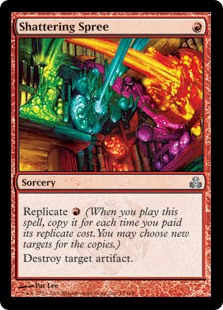 Shatterstorm does exactly one thing: sweep the board of artifacts. This is only relevant against decks that flood the board with artifacts. There are quite a few of them right now, but it's not universal. Against many deck with few artifacts, such as Eldrazi Tron, decks are better off with Spree since it's far cheaper.
Shatterstorm does exactly one thing: sweep the board of artifacts. This is only relevant against decks that flood the board with artifacts. There are quite a few of them right now, but it's not universal. Against many deck with few artifacts, such as Eldrazi Tron, decks are better off with Spree since it's far cheaper.
Splashability: 2
Decks need to be less committed to red for Shatterstorm than Spree, which is a huge bonus. However, only slower decks can afford to cast a four mana answer. The former makes Shatterstorm more splashable, the latter makes it less, and cost is a much bigger concern than color dependency.
#4: Alpine Moon: 11/15
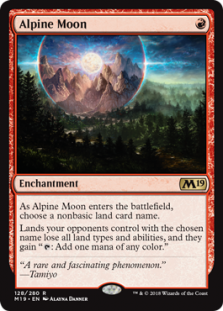 There are a lot of decks running Urza's Saga. There are a lot of decks running Valakut, the Molten Pinnacle. And also Tron's always hanging around. These are all decks that Blood Moon is very strong against. The problem is that a lot of decks that want to answer Valakut, Saga, and Tron are also very badly hurt by Blood Moon. The solution that is not seeing enough play is Alpine Moon. It's a one-sided effect that surgically removes the problem land from consideration.
There are a lot of decks running Urza's Saga. There are a lot of decks running Valakut, the Molten Pinnacle. And also Tron's always hanging around. These are all decks that Blood Moon is very strong against. The problem is that a lot of decks that want to answer Valakut, Saga, and Tron are also very badly hurt by Blood Moon. The solution that is not seeing enough play is Alpine Moon. It's a one-sided effect that surgically removes the problem land from consideration.
Efficacy: 3
Moon straight-up kills Urza's Saga upon resolution. It merely nerfs any other land it targets. This is usually worthwhile since preventing fast Valakut kills or Tron is critical for many decks. The problem is that Moon is quite vulnerable to removal. I'd rate Pithing Needle similarly: It's very good at what it does for it's price, but should not be the sole solution to a problem because it can't remove the problem from play.
Meta Versatility: 5
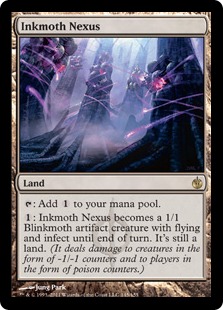 The cards a specifically mentioned see play in many decks. However, almost every deck has some land that's worth naming with Moon: Blinkmoth Nexus, Fiery Islet, manlands, and utility lands are everywhere. It's not always necessary to Moon every deck to win, but the fact that Moon has value against the vast majority of decks gives it huge versatility points.
The cards a specifically mentioned see play in many decks. However, almost every deck has some land that's worth naming with Moon: Blinkmoth Nexus, Fiery Islet, manlands, and utility lands are everywhere. It's not always necessary to Moon every deck to win, but the fact that Moon has value against the vast majority of decks gives it huge versatility points.
Splashability: 3
Being one mana is a huge plus. Being red is another huge plus, especially when a very large part of the metagame is running red. The problem is that there is also a significant part of the metagame running the targeted lands. Those decks that want Moon can pack it readily, but it shakes out such that there aren't too many that do. More should, but not every deck.
#3: Rest in Peace: 11/15
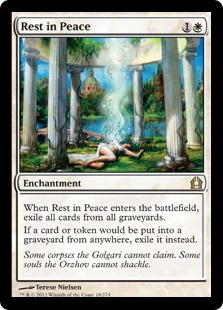 This is Modern. The graveyard is an essential resource. Has been for years, and continues to be so right now. The difference: at the moment, the main use is Dragon Rage Channeler's delirium and delve for Murktide Regent, with Cookbook/Ovalchase Daredevil synergy thrown in for good measure. Which makes it so weird to me that decks are running one-shot disruption rather than continuous hate. Even those without any graveyard cards themselves. I suspect that desire to play with Abnormal Endurance is driving the decision, but the ease with which Food decks in particular play around such hate makes me seriously question the decision.
This is Modern. The graveyard is an essential resource. Has been for years, and continues to be so right now. The difference: at the moment, the main use is Dragon Rage Channeler's delirium and delve for Murktide Regent, with Cookbook/Ovalchase Daredevil synergy thrown in for good measure. Which makes it so weird to me that decks are running one-shot disruption rather than continuous hate. Even those without any graveyard cards themselves. I suspect that desire to play with Abnormal Endurance is driving the decision, but the ease with which Food decks in particular play around such hate makes me seriously question the decision.
Efficacy: 5
There is no better piece of graveyard hate in Magic than Rest in Peace. For a paltry two mana, there are no more graveyards for as long as Rest stays on the battlefield. No additional mana required. What sets Rest apart from Leyline of the Void is that it also removes the cards already in the graveyard, which ensures that any value stops immediately upon resolution. No. More. Graveyard value. Nothing else says it better.
Meta Versatility: 3
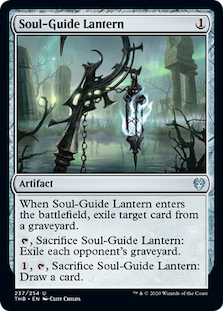 There are a lot of decks which Rest is very important against. However, there are plenty of others against which Rest has no utility. Not every deck has graveyard synergy, and some that do have so little that Rest is overkill and Soul-Guide Lantern is more appropriate.
There are a lot of decks which Rest is very important against. However, there are plenty of others against which Rest has no utility. Not every deck has graveyard synergy, and some that do have so little that Rest is overkill and Soul-Guide Lantern is more appropriate.
Splashability: 3
Rest is cheap in absolute and color-requirement terms, meaning that any deck that can make white mana can play it. However, many decks want to use their own graveyards, too. Rest is a blunt tool while many decks might prefer a surgical one. Just like Alpine Moon, every deck that wants Rest can easily splash it, but not every deck that can wants to.
#2: Chalice of the Void: 13/15
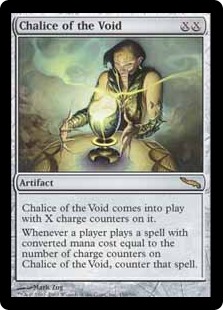
For a very long time, the only real use of Chalice of the Void was to lock out one-drops. Thus, it was only useful in very specific matchups by very specific decks, by which I mainly mean Eldrazi Tron. This is no longer the case. The proliferation of cascade decks has changed everything, and far more decks should be running Chalice.
Efficacy: 5
In terms of cheaply answering cascade decks, nothing is better than Chalice. It literally costs nothing to lock all the cascade decks out of their signature spells. Against Living End or Glimpse of Tomorrow, Chalice is a death sentence and must be removed. The Crashing Footfalls deck is severely hampered, but can win without free rhinos. Chalice is also legendary against Prowess and similar decks in Modern, just as it is against Delver in Legacy, and this is more relevant now than ever before.
Meta Versatility: 4
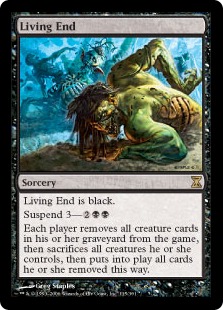 As mentioned, it is very strong against the cascade decks. They see a lot of play and there are a wide variety of them. It is also very effective against the numerous UR Channeler decks that have been the everywhere. It's even strong in multiples, as a Chalice on zero stops cascade spells and Mishra's Bauble and another Chalice on two stops all the maindeck answers to Chalice in those decks.
As mentioned, it is very strong against the cascade decks. They see a lot of play and there are a wide variety of them. It is also very effective against the numerous UR Channeler decks that have been the everywhere. It's even strong in multiples, as a Chalice on zero stops cascade spells and Mishra's Bauble and another Chalice on two stops all the maindeck answers to Chalice in those decks.
Splashability: 4
Besides cascade decks themselves and Affinity, every deck can cast Chalice for 0. That part is eminently splashable, and even for those decks with Bauble it's better to shut down your long-game value engine than lose to Living End. However, outside that use, Chalice gets trickier. Few decks won't be hit by their own Chalice on one or higher. Also, as a practical matter, Chalice is quite expensive to acquire. I don't begrudge Modern players for not running Chalice, even if it is underplayed.
#1: Path to Exile: 14/15
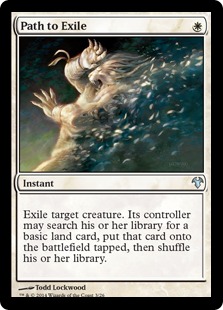 Why is it that Path is seeing less play now than it did a month ago when the number of targets it has is increasing? Especially targets that only it can answer for one mana? Prismatic Ending and City of Solitude are the answer. Which I find infuriating when so many players are complaining about Murktide Regent or getting killed at instant speed by Hammer Time. Ending is a very versatile card and answers a lot of the same things Path does, but at sorcery speed. And it can't hit the costly threats that are starting to pop up everywhere. City of Solitude doesn't ramp opponents, but this is balanced by it costing another white card. Players seem to prefer playing the more contextual answers and complaining about unkillable threats than just running more Paths right now.
Why is it that Path is seeing less play now than it did a month ago when the number of targets it has is increasing? Especially targets that only it can answer for one mana? Prismatic Ending and City of Solitude are the answer. Which I find infuriating when so many players are complaining about Murktide Regent or getting killed at instant speed by Hammer Time. Ending is a very versatile card and answers a lot of the same things Path does, but at sorcery speed. And it can't hit the costly threats that are starting to pop up everywhere. City of Solitude doesn't ramp opponents, but this is balanced by it costing another white card. Players seem to prefer playing the more contextual answers and complaining about unkillable threats than just running more Paths right now.
Efficacy: 5
One mana, exile target creature. It doesn't get more efficient or permanent than that. And considering that removing large creatures at instant speed is especially important right now, Path is particularly potent.
Meta Versatility: 4
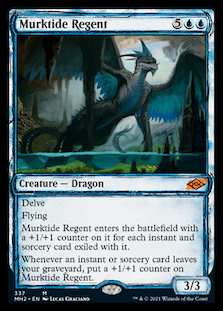 The only decks that don't have creatures that you want to Path are some control lists and Ad Nauseam. That's not enough to worry about, but the bigger concern is that Path does ramp opponents. This is a large part of its drop off since one mana creatures are seeing more play now than before. However, this is balanced for me by instant speed, equivocality, and price.
The only decks that don't have creatures that you want to Path are some control lists and Ad Nauseam. That's not enough to worry about, but the bigger concern is that Path does ramp opponents. This is a large part of its drop off since one mana creatures are seeing more play now than before. However, this is balanced for me by instant speed, equivocality, and price.
Splashability: 5
Any deck that's white that wants to kill creatures can run Path. The fact that more don't is mystifying to me, given delve creatures, construct tokens, and Primeval Titan being very popular.
Right Card for the Job
There are reasons that all of these cards aren't seeing much play at the moment. However, I don't think they outweigh the positives of running them, and that's why they are underplayed. Before players complain about broken cards, I wished they'd reexamine and adjust their own card choices.



